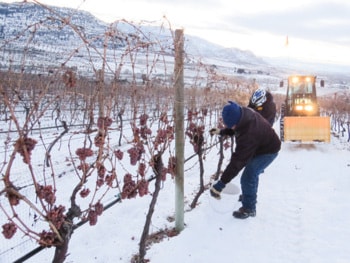Troy Osborne is hoping for one more blast of cold air from the Arctic.
Osborne, an Oliver vineyard manager, spent Friday night and the very early hours Saturday morning in two South Okanagan vineyards, trying to get frozen grapes picked as temperatures hit the right level of freezing to produce the high sugar juice needed to make sweet ice wine.
While he and his crews cleared one vineyard, one more super cold night is needed to clear a second.
“We have two sites that we harvest our Riesling grapes,” said Osborne. Picking began at Whitetail vineyards in Oliver at 9 p.m. as temperatures dipped to −12 C, but at 3 a.m. the crew moved on to Inniskillin’s Dark Horse Vineyards as temperatures hit the magic levels there.
“On the Dark Horse site we cleared that area off and there are 15 to 20 tons left on the Whitetail site,” said Osborne. “We need another night. If we had another night, we would get’er.”
This year, wine makers were lucky to get ideal temperatures for the grapes, with the combination of a long, warm, growing season combining with the weekend blast of subzero weather to produce the right level of sugar for ice wine.
“We really needed those temperatures and lower. The later you go in the year, the harder it is to freeze the grapes because they become dehydrated,” said Osborne. “It’s nothing but sugar; it’s like trying to freeze antifreeze.”
While ice wine picking can occur as late as March, it is an anxiety-laden wait for vineyards owners who make a choice to leave grapes on the vine in hope of making the high-value ice wine.
“Once we make the commitment that it’s ice wine, it’s all or nothing. Ideally we want it to happen before the new year’s break,” said Osborne. It was close earlier in the season a few times, including New Year's Eve, he continued, but temperatures never quite dropped low enough. “New Year's Eve, my crew was all assembled. They gave up their New Year’s Eve party to hang around a shop, waiting for the right level of sugar to hit.”
Over on the Naramata Bench, Steve Latchford, wine maker at Therapy Vineyards, faced similar problems.
“We had a couple of close calls where we hit −6 C and −7 C just before Christmas. And right on New Year's Eve we got pretty close again too,” said Latchford, who managed to get his crop in starting at 7 a.m. Saturday.
“We were almost getting to the point where I was looking at doing a late harvest instead of an ice wine because they were starting to break down a little bit with all these cold flashes and warm flashes,” said Latchford. “Luckily, we got it, and everything is off and in tanks. We dodged a bullet there.”
“Everything was great, the Pinot Gris looked really good, nice amounts of Botrytis infection, so we got really concentrated sugar quantities in the pressed juice,” said Latchford. It is unusual to use Pinot Gris for ice wine, but Latchford said he prefers the higher acidity of the grapes.
“You have a lot of acidity that balances out that sugar, so it’s not just a big sugary viscous syrup. You get a bit of acid to cut through it,” he said.
While choosing to make ice wine is a calculated risk for wine makers, the sector of the wine industry has grown substantially since Peachland grower Walter Hainle produced the first Canadian ice wine in 1972.
Besides Therapy, several other Naramata Bench Vineyards are reporting successful ice wine harvests, including D’Angelo, Van Westen and Lang Vineyards, all part of making Canada one of the world’s most prominent ice wine producers.
